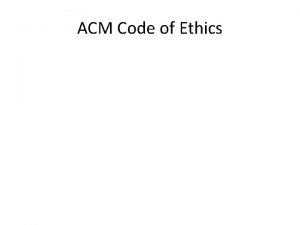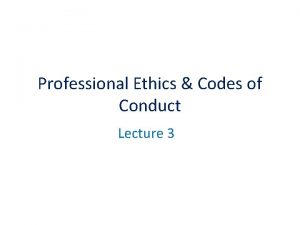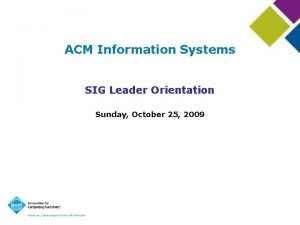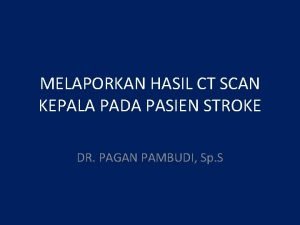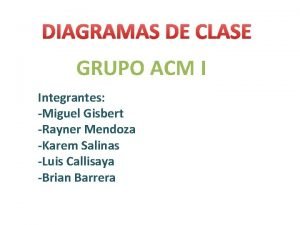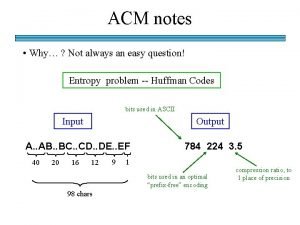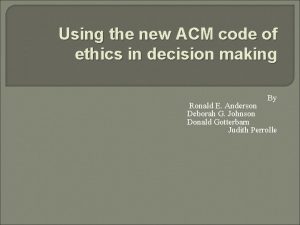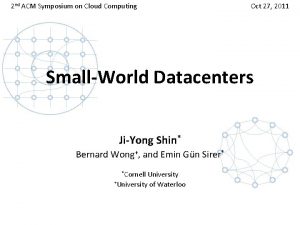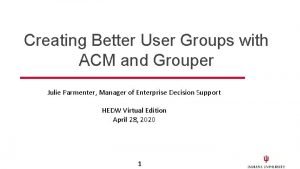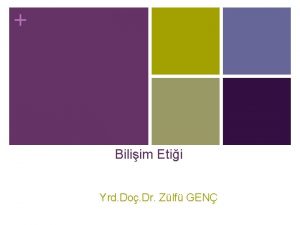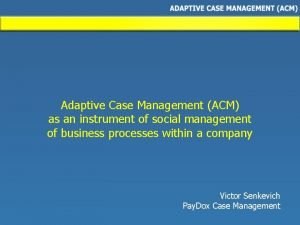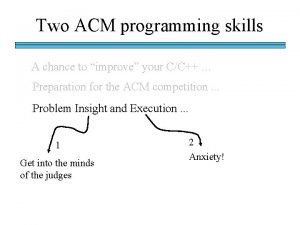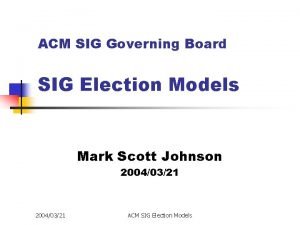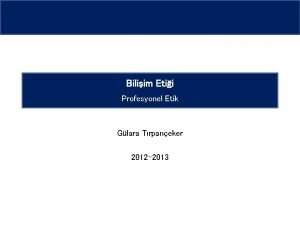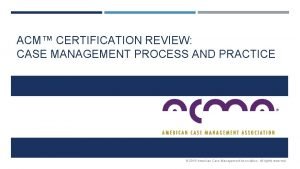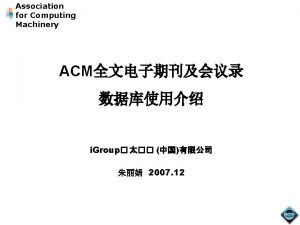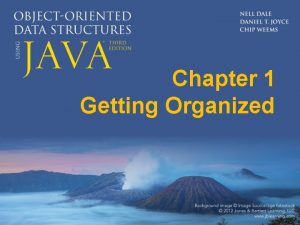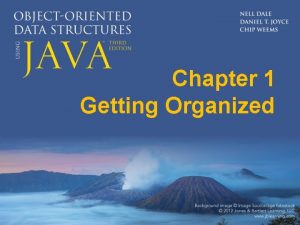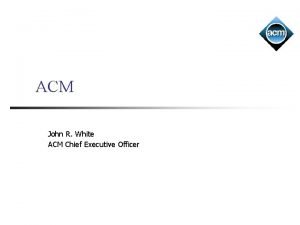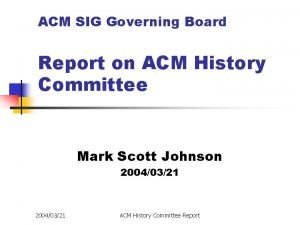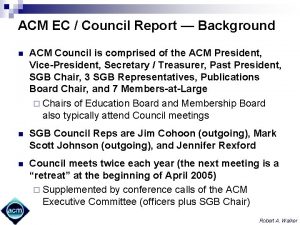ACM today The Fall competition is getting organized




![Infinities seen… int BIG = 10000000; grid[j][k] = 1000000; Michael E. Scott P. Infinities seen… int BIG = 10000000; grid[j][k] = 1000000; Michael E. Scott P.](https://slidetodoc.com/presentation_image/39fe05896b89cc5f01b34155fe733027/image-5.jpg)
![Infinities seen… int BIG = 10000000; grid[j][k] = 1000000; paths[i][j] = 9001; Michael E. Infinities seen… int BIG = 10000000; grid[j][k] = 1000000; paths[i][j] = 9001; Michael E.](https://slidetodoc.com/presentation_image/39fe05896b89cc5f01b34155fe733027/image-6.jpg)
![Infinities seen… int BIG = 10000000; grid[j][k] = 1000000; paths[i][j] = 9001; direct = Infinities seen… int BIG = 10000000; grid[j][k] = 1000000; paths[i][j] = 9001; direct =](https://slidetodoc.com/presentation_image/39fe05896b89cc5f01b34155fe733027/image-7.jpg)
![Infinities seen… int BIG = 10000000; grid[j][k] = 1000000; paths[i][j] = 9001; direct = Infinities seen… int BIG = 10000000; grid[j][k] = 1000000; paths[i][j] = 9001; direct =](https://slidetodoc.com/presentation_image/39fe05896b89cc5f01b34155fe733027/image-8.jpg)
![Infinities seen… int BIG = 10000000; grid[j][k] = 1000000; paths[i][j] = 9001; direct = Infinities seen… int BIG = 10000000; grid[j][k] = 1000000; paths[i][j] = 9001; direct =](https://slidetodoc.com/presentation_image/39fe05896b89cc5f01b34155fe733027/image-9.jpg)
![Infinities seen… int BIG = 10000000; Michael E. grid[j][k] = 1000000; Scott P. paths[i][j] Infinities seen… int BIG = 10000000; Michael E. grid[j][k] = 1000000; Scott P. paths[i][j]](https://slidetodoc.com/presentation_image/39fe05896b89cc5f01b34155fe733027/image-10.jpg)
![Infinities seen… int BIG = 10000000; Michael E. grid[j][k] = 1000000; Scott P. paths[i][j] Infinities seen… int BIG = 10000000; Michael E. grid[j][k] = 1000000; Scott P. paths[i][j]](https://slidetodoc.com/presentation_image/39fe05896b89cc5f01b34155fe733027/image-11.jpg)
![Infinities seen… int BIG = 10000000; Michael E. grid[j][k] = 1000000; Scott P. paths[i][j] Infinities seen… int BIG = 10000000; Michael E. grid[j][k] = 1000000; Scott P. paths[i][j]](https://slidetodoc.com/presentation_image/39fe05896b89cc5f01b34155fe733027/image-12.jpg)



































- Slides: 47

ACM today The Fall competition is getting organized… it's going to be lonely…

Mock mock contest #2 More teams solved problems; more problems were solved All problems solved by some team shipping all-pairs shortest paths could be used for this one… Still one computer per team… API-reference is OK on another machine forward following calls through a graph of forwarding instructions panic

Infinities seen…

Infinities seen… int BIG = 10000000; Michael E.
![Infinities seen int BIG 10000000 gridjk 1000000 Michael E Scott P Infinities seen… int BIG = 10000000; grid[j][k] = 1000000; Michael E. Scott P.](https://slidetodoc.com/presentation_image/39fe05896b89cc5f01b34155fe733027/image-5.jpg)
Infinities seen… int BIG = 10000000; grid[j][k] = 1000000; Michael E. Scott P.
![Infinities seen int BIG 10000000 gridjk 1000000 pathsij 9001 Michael E Infinities seen… int BIG = 10000000; grid[j][k] = 1000000; paths[i][j] = 9001; Michael E.](https://slidetodoc.com/presentation_image/39fe05896b89cc5f01b34155fe733027/image-6.jpg)
Infinities seen… int BIG = 10000000; grid[j][k] = 1000000; paths[i][j] = 9001; Michael E. Scott P. Martin P.
![Infinities seen int BIG 10000000 gridjk 1000000 pathsij 9001 direct Infinities seen… int BIG = 10000000; grid[j][k] = 1000000; paths[i][j] = 9001; direct =](https://slidetodoc.com/presentation_image/39fe05896b89cc5f01b34155fe733027/image-7.jpg)
Infinities seen… int BIG = 10000000; grid[j][k] = 1000000; paths[i][j] = 9001; direct = 2400; Michael E. Scott P. Martin P. Russ R.
![Infinities seen int BIG 10000000 gridjk 1000000 pathsij 9001 direct Infinities seen… int BIG = 10000000; grid[j][k] = 1000000; paths[i][j] = 9001; direct =](https://slidetodoc.com/presentation_image/39fe05896b89cc5f01b34155fe733027/image-8.jpg)
Infinities seen… int BIG = 10000000; grid[j][k] = 1000000; paths[i][j] = 9001; direct = 2400; int constant = 1000; Michael E. Scott P. Martin P. Russ R. Zvi E.
![Infinities seen int BIG 10000000 gridjk 1000000 pathsij 9001 direct Infinities seen… int BIG = 10000000; grid[j][k] = 1000000; paths[i][j] = 9001; direct =](https://slidetodoc.com/presentation_image/39fe05896b89cc5f01b34155fe733027/image-9.jpg)
Infinities seen… int BIG = 10000000; grid[j][k] = 1000000; paths[i][j] = 9001; direct = 2400; int constant = 1000; public static int Inf = 200; Michael E. Scott P. Martin P. Russ R. Zvi E. George T.
![Infinities seen int BIG 10000000 Michael E gridjk 1000000 Scott P pathsij Infinities seen… int BIG = 10000000; Michael E. grid[j][k] = 1000000; Scott P. paths[i][j]](https://slidetodoc.com/presentation_image/39fe05896b89cc5f01b34155fe733027/image-10.jpg)
Infinities seen… int BIG = 10000000; Michael E. grid[j][k] = 1000000; Scott P. paths[i][j] = 9001; Martin P. direct = 2400; Russ R. int constant = 1000; Zvi E. public static int Inf = 200; George T. adjacency[a][b] = 0; Andrew H.
![Infinities seen int BIG 10000000 Michael E gridjk 1000000 Scott P pathsij Infinities seen… int BIG = 10000000; Michael E. grid[j][k] = 1000000; Scott P. paths[i][j]](https://slidetodoc.com/presentation_image/39fe05896b89cc5f01b34155fe733027/image-11.jpg)
Infinities seen… int BIG = 10000000; Michael E. grid[j][k] = 1000000; Scott P. paths[i][j] = 9001; Martin P. direct = 2400; Russ R. int constant = 1000; Zvi E. public static int Inf = 200; George T. adjacency[a][b] = 100; Andrew H. int infinity = 31; Kwang K.
![Infinities seen int BIG 10000000 Michael E gridjk 1000000 Scott P pathsij Infinities seen… int BIG = 10000000; Michael E. grid[j][k] = 1000000; Scott P. paths[i][j]](https://slidetodoc.com/presentation_image/39fe05896b89cc5f01b34155fe733027/image-12.jpg)
Infinities seen… int BIG = 10000000; Michael E. grid[j][k] = 1000000; Scott P. paths[i][j] = 9001; Martin P. direct = 2400; Russ R. int constant = 1000; Zvi E. public static int Inf = 200; George T. adjacency[a][b] = 100; Andrew H. int infinity = 31; Kwang K. #define INFINITE 0 x 0 fffffff Andrew F.

Infinities seen… int hashnode(char *buf) { int hv = 0; while(*buf) { hv <<= 6; hv |= *buf++ & 31; } return hv; } int BIG = 10000000; Michael E. grid[j][k] = 1000000; Scott P. paths[i][j] = 9001; Martin P. direct = 2400; Russ R. int constant = 1000; Zvi E. public static int Inf = 200; George T. adjacency[a][b] = 100; Andrew H. int infinity = 31; Kwang K. #define INFINITE 0 x 0 fffffff Andrew F. 268435455 for (int woo = 0; woo < tries; woo++) {

Schedule 10/2/2007 Today -- search and related problems 10/9/2007 Lab / mock contest 10/16/2007 10/23/2007 one more algorithm No class: conference & fall break… 10/30/2007 Real mock contest - "real" rules apply 9 pm to 1 am Tuesday, 10/30 11/6/2007 Meeting for ACM teams 11/13/2007 Final CS 189 meeting: contest wrap-up

Max Flow Ford-Fulkerson algorithm B 16 10 A 12 4 D 9 sink F 7 source 13 20 4 C 14 E capacity The problem how much traffic can get from the source to the sink ?

Max Flow The problem how much traffic can get from the source to the sink ? B 16 10 A 12 4 D 9 20 F 7 source 13 sink 4 C 14 “Capacity Graph” E C capacity FROM A B C D E F TO A B - 16 13 - - 10 12 - 4 - 14 - 9 - 20 - - C - D 7 - E F - 4 -

Find a path in C via BFS The problem how much traffic can get from the source to the sink ? B 16 10 A 12 4 D 9 need to add this into here… 20 F 7 source 13 sink 4 C 14 E C capacity FROM A B C D E F TO A B - 16 13 - - 10 12 - 4 - 14 - 9 - 20 - - C - D 7 - E F - 4 -

Create F Create a FLOW GRAPH with the minimum weight from that path B 16 12 A 12 12 D 20 12 10 4 9 F 7 source 13 sink 4 C 14 “Flow Graph” E F capacity flow in one direction is negative flow in the other direction FROM A B C D E F TO A C D E F - 12 0 -12 - 0 0 - -12 0 12 - - - 0 - 12 0 -12 - - B - - 0 -

R=C-F Create a RESIDUAL GRAPH with the rest of the capacity after that flow B 4 12 A 10 0 D 12 8 12 4 9 F 7 source 13 sink 4 C 14 “Residual Graph” E R capacity reverse edges allow the "undoing" of previous flow! FROM A B C D E F TO A 12 - B C D E F 4 13 - 10 4 12 9 0 - - - 14 - 8 - - 7 12 - 4 -

Keep going! Continue running this on the residual capacity until BFS fails… B 11/16 0/10 A 1/4 12/12 0/9 D 4/4 C 11/14 E There is no longer a path from A to F ! sink F 7/7 source 12/13 19/20

1. Set F to all 0 2. Compute R = C - F 3. BFS in R from source to sink. 3 a. If no path, you’re done. 3 b. If a path, add the available capacity to F; goto (2). The max flow algorithm Floyd-Fulkerson 16 4 1 10 A 4 2 A 11 0 4 2 9 sink F 1 7 4 E flow D 7 5 9 5 14 residual 9 9 5 2 C capacity 3 20 4 13 B D 2 source 12 12 3 B 1 6 E 18 2 F 4 “Residual Graph” Don't need to keep R around explicity: Keep only the current flow (F) and the original capacity (C).

Pseudo-code (Python) def edmonds_karp(C, source, sink): n = len(C) # C is the capacity matrix F = [[0] * n for i in range(n)] # F is the flow matrix # residual capacity from u to v is C[u][v] - F[u][v] while True: path = BFS(C, F, source, sink) if not path: break flow = float(1 e 309) # Infinity ! # traverse path to find smallest capacity for (u, v) in path: flow = min(flow, C[u][v] - F[u][v]) # traverse path to update flow for u, v in path: F[u][v] += flow F[v][u] -= flow return sum([F[source][i] for i in xrange(n)]) Get into the flow! A little bit of name contention… edmonds_karp is really Ford-Fulkerson, but with other people getting the credit… def BFS(C, F, source, sink): queue = [source] paths = {source: []} while queue: u = queue. pop(0) for v in range(len(C)): if C[u][v] - F[u][v] > 0 and v not in paths: # Python == English ! paths[v] = paths[u] + [(u, v)] if v == sink: return paths[v] queue. append(v) return None

Max flow examples… Dinner problem tables with capacities 3 Circuses problem 5 Circus inspectors need to visit every circus -starting from anywhere. A B 2 6 3 C D team sizes 4 5 3 5 There are M teams with M[i] team members T tables with T[i] seating capacity No two members from one team should share a table. Can you still seat everyone? F E G What is the smallest # of inspectors needed to visit each node without overlap?

How does maxflow help… ? The problem Fewest number of people to reach all nodes without coinciding. . . S A B C D E F G D F E G T one instance graph of constraints answer is N-maxflow (all edges 1 unit)

Pseudo-code (Python) def edmonds_karp(C, source, sink): n = len(C) # C is the capacity matrix F = [[0] * n for i in range(n)] # F is the flow matrix # residual capacity from u to v is C[u][v] - F[u][v] while True: path = BFS(C, F, source, sink) if not path: break flow = float(1 e 309) # Infinity ! # traverse path to find smallest capacity for (u, v) in path: flow = min(flow, C[u][v] - F[u][v]) # traverse path to update flow for u, v in path: F[u][v] += flow F[v][u] -= flow return sum([F[source][i] for i in xrange(n)]) def BFS(C, F, source, sink): queue = [source] paths = {source: []} while queue: u = queue. pop(0) for v in range(len(C)): if C[u][v] - F[u][v] > 0 and v not in paths: paths[v] = paths[u] + [(u, v)] if v == sink: return paths[v] queue. append(v) return None Get into the flow! A little bit of name contention… edmonds_karp is really Floyd-Fulkerson, but with other people getting the credit… many problems require no more than BFS or DFS

Problem Set #5: Search algorithms, etc. orchard gumbo getout sq circuses

Subdividing Squares Input orchard gumbo getout 3 4 3 7 2 1 # of problems 1 3 side length in the larger square sq circuses smallest number of smaller squares covering the original 4 6 9 Output 9 smaller squares that cover a larger 7 x 7 square.

Counting trees Input 1. 5 0. 9 1. 5 6. 8 1. 1 0. 9 orchard. X 6. 8 1. 5 1. 1 0. 9 1. 1 vertices of a polygon on a single line of input 7, 7 Output 0, 0 right-justified number of lattice points in each polygon 15 1

Java Geometry

Ascii Geometry START 3 Input -10, -2, 1 number of bullets to be fired 300, 14. 5, -20 velocity of the target 350, -80, 0 400, 28. 75, 26 bullet velocities: N, E, up @@@@ n #^^# o. U target shape ## o oooooo o DDDD the bullets are fired 10 m due oo DDDD south of the center of the target D D TT TT <TTT TTT> END getout. X

Ascii Geometry START 3 Input -10, -2, 1 number of bullets to be fired 300, 14. 5, -20 velocity of the target 350, -80, 0 400, 28. 75, 26 bullet velocities: N, E, up @@@@ n #^^# o. U target shape ## o oooooo o DDDD the bullets are fired 10 m due oo DDDD south of the center of the target D D each ASCII character TT TT is 10 cm x 10 cm TT TT <TTT TTT> END getout. X Output asterisk indicating hits @@@@ * #^^# o. U ## o oooooo o DDDD oo DDDD D D TT TT <TTT TTT> Matt Streshinsky…


Jotto… Sophomores Juniors Seniors Me fjord 3 fjord 0 fjord 1 fjord 2 tempt 1 tempt 2 tempt 0 marks 1 marks 3 marks 0 marks 1 diner 0 diner 2 chore 0 chore 1

See you next week!

ACM today The Fall competition is getting organized…

Schedule 10/2/2007 Today -- search and misc problems 10/9/2007 Lab / mock contest 10/16/2007 10/23/2007 No class: conference & fall break… 10/30/2007 Real mock contest - "real" rules apply 9 pm to 1 am Tuesday, 10/30 11/6/2007 Meeting for ACM teams 11/13/2007 Final CS 189 meeting: contest wrap-up

Max Flow The problem how much traffic can get from the source to the sink ? B 16 10 A 12 4 D 9 20 F 7 source 13 sink 4 C 14 “Capacity Graph” E C capacity FROM A B C D E F TO A B - 16 13 - - 10 12 - 4 - 14 - 9 - 20 - - C - D 7 - E F - 4 -

Create F Create a FLOW GRAPH with the minimum weight from that path B 16 12 A 12 12 D 20 12 10 4 9 F 7 source 13 sink 4 C 14 “Flow Graph” E F capacity flow in one direction is negative flow in the other direction FROM A B C D E F TO A C D E F - 12 0 -12 - 0 0 - -12 0 12 - - - 0 - 12 0 -12 - - B - - 0 -

R=C-F Create a RESIDUAL GRAPH with the rest of the capacity after that flow B 4 12 A 10 0 D 12 8 12 4 9 F 7 source 13 sink 4 C 14 “Residual Graph” E R capacity reverse edges allow the "undoing" of previous flow! FROM A B C D E F TO A 12 - B C D E F 4 13 - 10 4 12 9 0 - - - 14 - 8 - - 7 12 - 4 -

Keep going! Continue running this on the residual capacity until BFS fails… B 11/16 0/10 A 1/4 12/12 0/9 D 4/4 C 11/14 E There is no longer a path from A to F ! sink F 7/7 source 12/13 19/20

1. Set F to all 0 2. Compute R = C - F 3. BFS in R from source to sink. 4 a. If no path, you’re done. 4 b. If a path, add the available capacity to F; goto (2). The max flow algorithm Floyd-Fulkerson 16 4 1 10 A 4 2 A 11 0 4 2 9 sink F 1 7 4 E flow D 7 5 9 5 14 residual 9 9 5 2 C capacity 3 20 4 13 B D 2 source 12 12 3 B 1 6 E 18 2 F 4 “Residual Graph” Don't need to keep R around explicity: Keep only the current flow (F) and the original capacity (C).

Pseudo-code (Python) def edmonds_karp(C, source, sink): n = len(C) # C is the capacity matrix F = [[0] * n for i in range(n)] # F is the flow matrix # residual capacity from u to v is C[u][v] - F[u][v] while True: path = BFS(C, F, source, sink) if not path: break flow = float(1 e 309) # Infinity ! # traverse path to find smallest capacity for (u, v) in path: flow = min(flow, C[u][v] - F[u][v]) # traverse path to update flow for u, v in path: F[u][v] += flow F[v][u] -= flow return sum([F[source][i] for i in xrange(n)]) def BFS(C, F, source, sink): queue = [source] paths = {source: []} while queue: u = queue. pop(0) for v in range(len(C)): if C[u][v] - F[u][v] > 0 and v not in paths: paths[v] = paths[u] + [(u, v)] if v == sink: return paths[v] queue. append(v) return None Get into the flow! A little bit of name contention… edmonds_karp is really Floyd-Fulkerson, but with other people getting the credit…

Max flow examples… Dinner problem tables with capacities 3 Circuses problem 5 Circus inspectors need to visit every circus -starting from anywhere. A B 2 6 3 C D team sizes 4 5 3 5 There are M teams with M[i] team members T tables with T[i] seating capacity No two members from one team should share a table. Can you still seat everyone? F E G What is the smallest # of inspectors needed to visit each node without overlap?

Subdividing Squares Input orchard gumbo getout 3 4 3 7 2 1 # of problems 1 3 side length in the larger square sq circuses smallest number of smaller squares covering the original 4 6 9 Output 9 smaller squares that cover a larger 7 x 7 square.

Java Geometry

Jotto… Sophomores Juniors Seniors Me fjord 3 fjord 0 fjord 1 fjord 2 tempt 1 tempt 2 tempt 0 marks 1 marks 3 marks 0 marks 1

Ascii Geometry 2 0 0 0 1 0 2 1 2 -1 3 1 1 1 0 -1 0 Input 2 0 0 1 2 2 2 1 2 3 1 0 0 1 1 1 0 getout. X number of dimensions starting point and destination point edges in the graph 2 1 0 0 3 3 3 0 0 0 next number of dimensions 0 2 Output Maze #1 can be traveled Maze #2 cannot be traveled 0 1 0 0 1 2 2 2
 Getting ahead
Getting ahead Perfect competition vs monopolistic competition
Perfect competition vs monopolistic competition Characteristics of a monopoly
Characteristics of a monopoly Perfect competition vs monopolistic competition
Perfect competition vs monopolistic competition Pure competition vs monopolistic competition venn diagram
Pure competition vs monopolistic competition venn diagram Fingerprint ridge characteristics worksheet
Fingerprint ridge characteristics worksheet For today's meeting
For today's meeting Today's lesson or today lesson
Today's lesson or today lesson There is class today
There is class today Today's lesson or today lesson
Today's lesson or today lesson Meeting objective
Meeting objective Acm ethics corporate
Acm ethics corporate General moral imperatives
General moral imperatives Acm awards
Acm awards Acm
Acm Ventrikel 4 ct scan
Ventrikel 4 ct scan Scott delman acm
Scott delman acm Acm
Acm Acm code of conduct
Acm code of conduct Bộ quy tắc ứng xử acm
Bộ quy tắc ứng xử acm Acm code of ethics summary
Acm code of ethics summary Acm symposium on cloud computing
Acm symposium on cloud computing Acm icpc
Acm icpc Acm
Acm Grouper active directory
Grouper active directory Acm/ieee etik kuralları
Acm/ieee etik kuralları Acm adaptive case management
Acm adaptive case management Acm sigs sigsac
Acm sigs sigsac Acm
Acm Acm icpc
Acm icpc Acm international academy
Acm international academy Acm
Acm Acm/ieee etik kuralları
Acm/ieee etik kuralları Asbestos removal bonbeach
Asbestos removal bonbeach Acm practice test
Acm practice test Ieee acm springer elsevier
Ieee acm springer elsevier Vẽ hình chiếu đứng bằng cạnh của vật thể
Vẽ hình chiếu đứng bằng cạnh của vật thể Thế nào là sự mỏi cơ
Thế nào là sự mỏi cơ Phản ứng thế ankan
Phản ứng thế ankan Voi kéo gỗ như thế nào
Voi kéo gỗ như thế nào Thiếu nhi thế giới liên hoan
Thiếu nhi thế giới liên hoan điện thế nghỉ
điện thế nghỉ Sơ đồ cơ thể người
Sơ đồ cơ thể người Một số thể thơ truyền thống
Một số thể thơ truyền thống Trời xanh đây là của chúng ta thể thơ
Trời xanh đây là của chúng ta thể thơ Thế nào là hệ số cao nhất
Thế nào là hệ số cao nhất Slidetodoc
Slidetodoc Số.nguyên tố
Số.nguyên tố











